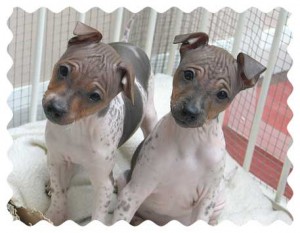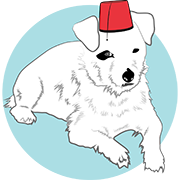
After posing the question on Sunday, How do pet allergies work? — geared towards determining how they affect travel — and checking into airplane policies, I thought I was going to have some definitive data to present.
Instead, I was left with more questions and:
— Awe at the commitment that several people with allergies have made to dogs and cats nevertheless. Two Twitter pals, @MelzPetPals and @Keeping_Awake, both of whom who work with animals, are particularly impressive. Deciding to undergo a variety of shots and medications in order to devote yourself to the furred is inspirational.
— A better knowledge of how pet allergies work, from various sufferers who wrote in and also from Sweet Lucy’s, a site devoted to hairless dogs (the pictures here are from that site’s fascinating photo gallery):
There is no dog breed that is truly non-allergenic (not allergy causing) because all dogs produce dander (shed skin cells), saliva, and urine. You can be allergic to the dog dander, dog saliva, or even dog urine. Urine is less of a problem since dogs usually potty outside. Pet hair itself is not an allergen, [italics mine — who knew?] but it can collect dander, dust, and pollen. The word hypo-allergenic (less allergy causing) is typically used with skin care products that tend to be less irritating to sensitive skin.
People with pet allergies have supersensitive immune systems that react to harmless proteins (allergens) in the pet’s dander, saliva or urine. These allergy-producing proteins can cause nasal congestion, sneezing, itchy and watery eyes, skin rashes, headaches, fatigue, coughing, shortness of breath, wheezing, and serious asthma attacks. This can happen within 5-30 minutes or occur much later as a delayed reaction. Based on pet allergy sufferers’ testimonials, it is possible to be allergic to all dogs or only to certain breeds.
Some dog breeds supposedly produce less dander than others, and many people who are mildly allergic to dogs can tolerate some of these “low dander” dog breeds with proper environmental controls. Sometimes people call these “low dander” dog breeds hypo-allergenic, low allergy, or allergy friendly.
Be careful though, as there are no guarantees! People’s pet allergies vary greatly. Severe pet allergy sufferers may not tolerate any dogs at all, even with the best environmental controls.
I therefore figured that was that, as far as air travel was concerned, except for people who are willing to drug themselves. And then my ever-alert pal Mary-Alice Pomputius of DogJaunt.com, sent in the following comment:
… people don’t realize just how clean airplane air really is. It is recirculated, but it’s also filtered — through HEPA filters — and there is typically a complete exchange of air between 10 and 15 times an hour. That’s darned good — better than most places humans occupy — but it’s not well known. Given that recirculation and filtration, I suspect that allergy sufferers would likely not be affected by the presence of a small pet on a plane — but as I’ve said before, there are no studies out there providing really reliable data. As a friend of mine pointed out, the plural of anecdote is not data.
Mary-Alice also provided a link to the Federal Aviation Administration’s (FAA) Q & A on “Pets in the Passenger Cabin,” which includes such information as:
Can I be sure that there will be no animals on my flight if an airline does not allow pets in the cabin?
No, you can’t be sure. The Department of Transportation (DOT) has rules (14 CFR part 382) (PDF) that require airlines to allow passengers to fly with their service animals in the cabin on all U.S. airlines.
And
I have severe allergies to pet dander. How can I be sure that there is no pet dander on my flight?
You will still be exposed to pet dander on every flight, even without any pets in the passenger cabin. This is because most allergens are carried into the cabin on the clothes of other passengers.
My favorite, however, is the list of stipulations that individual airlines may add on to the standard FAA regulations about pets traveling in the cabin, which includes:
A requirement that your pet be harmless, inoffensive and odorless
Would that such a requirement were in place for human passengers!
To read the rest of this Q & A, click here.


Indeed–that humans be harmless, inoffensive, and odorless!!!!! Plenty of women’s stinky perfume is offensive. Why is it that our dogs and cats who are living beings–not automatons–have to be perfect and we have to guarantee their ‘pefectness’ in any and all situations (impossible) regardless of how provocatively other behave toward them, or not matter what novel things might startle them causing a dog to, OMG, bark! And we need to remember that NO ONE is harmless! We all have are limits and so do our cats and dogs.
Yes, and I’m far more offended, say, by the political opinions of many people I’ve been stuck next to on flights than by anything a dog could do or bark.
That last line had me in stitches:) Thanks! And it’s an interesting point about allergens–we are all wearing out little Chloe’s and Frankie’s on our clothing, sharing them whereever we go. And allergies are cumulative so repeated exposures can trigger heightened response over time, which is why it’s better to medicate than go into possible anaphylactic shock – deadly.
This is probably why the people who are most affected freak. Since I have been there done that with an unexpected food allergy, I get it. I took immunotherapy for many years in the 80s for dog/cat/dust/mold/grass/sun….life allergies. I think a lot of people who now complain were told by their doctors that they must “get rid of” their pets and actually *followed* that prescription rather than refusing. Fear guides their protests.
Thanks Edie, great post – and thanks for including Mary-Alice’s comment about airplane air. Each time I have to sit and wait on a runway for an hour and it starts getting uncomfortably warm, I used to cringe thinking about the lack of clean air, equating stuffy thick air replete with the smell of humanity with dirty air. Now I’ll recall what she said!
I agree that we’re often too eager to follow authority to the detriment of life quality, which is why it was so nice to hear from people with allergies who not only kept their pets but ended up in pet-oriented professions. I also think that, now that I know the air is so strongly filtered in a plane, I’m less likely to think I’ll get sick from fellow passengers — and therefore less likely to actually get sick (yes, I’m a big believer in mind over matter).
Wow Edie! This turned out to be a very interesting question! I learned a lot from the answers you received and from this post. For instance, who knew that pet allergens comes from their dander, saliva AND urine? I had no idea!
Regarding your kind comments on my career choice: I think you are giving me more credit than I deserve. You see, I have always loved and rescued animals. I could no more choose to avoid animals than to breathe (which ironically, affects my breathing! LOL!). It is what I was born to do.
I had no idea about the urine either — and definitely learned a lot from all these different sources, too.
I know what you mean about needing to do what you need to do to be happy — but at the same time not everyone allows themselves their pleasure, using the barriers that exist as an excuse. So give yourself credit, too!
Thank you so much for the shout-out, Edie! It’s such a tough question, and provokes such extreme responses in people (though not, I’m happy to say, in the people who read your blog), that I think we’ll only get comfortable with it when the FAA funds a study about pets on airplanes. What am I saying? No doubt even then there will be strongly-expressed feelings….
When I consulted a prominent allergy m.d. for my allergies, it turned out that I had the typical dust, mold, pollen allergies. The allergy to dust is really to dust mites, not the actual dust. And worse, he pointed out to me, is that the primary “dust” upon which these mites love to feed is the skin that we humans constantly shed. Thus, I suppose in a leap of logic, I’m allergic to human dander. So when I get allergy symptoms on an airplane, is that to the humans? And couldn’t it be that many people are reacting to human dander when they think it’s pet dander. PLEASE realize I’m not referring to your always well-informed readers, but to the panicky public at large that likes to blame pets before humans.
That makes sense. Hmmm. I wonder if some humans are more hypoallergenic than others….
LOL! Perhaps we need to be breeding hypoallergenic humans! Humapoodle?
Hoodle? Pooman?
I truly sympathize with people who have allergies. I can’t imagine what it must feel like to have that stuffy, sick feeling throughout the year instead of with an occasional cold (and some folks have pretty severe reactions).
But I wonder how much harm we do by always trying to protect ourselves. More exposure, instead of less, may be key: http://www.hsus.org/pets/pets_related_news_and_events/study_early_exposure_to_pets_may_reduce_allergies.html.
My sister was allergic to cats but rescued one anyway. At first she suffered a lot. By restricting the cat’s access and washing her hands regularly, she has seen her allergy symptoms diminish over time.
Thank you very much for that link — it’s fascinating.
And that makes sense to me. I feel that way about germs, maybe because my parents were European and not as obsessed with removing every trace of bacteria from every surface as many American parents were/are. I continue in that tradition — and very rarely get sick.
Woof! Woof! Happy BLOG HOP Weekend. Lots of Golden Woofs, Sugar
I can’t imagine the concentration of allergens in our RV! We just open the windows, drive fast, and hope it all blows out. Pity the cars behind us!
Ah, just a different type of allergens from outdoors, right? Maybe a healthy recycling of dust mites? 😉
Hi Edie,
I thought I’d pop by and say hello. I love dogs – I should say that on a blog full of dog lovers – but I must admit to having a cat called Kit Kat. My sister bought Kit Kat to help with the mice problem – which is gone now – but when she moved in with her partner, the cat was left to me.
It is bad but every time I get bites, I wonder if it’s Kit Kat. And when he pukes out, I do get a bit nervous. I won’t go on about a cat on a dog website.
Thanks for popping by.
Thanks for stopping by, Jessie. Some of our best pet friends are cats!
I have such strong allergies I had to get rid of my cats and my dog. I now have a different problem: loneliness.
I’m sorry to hear that.